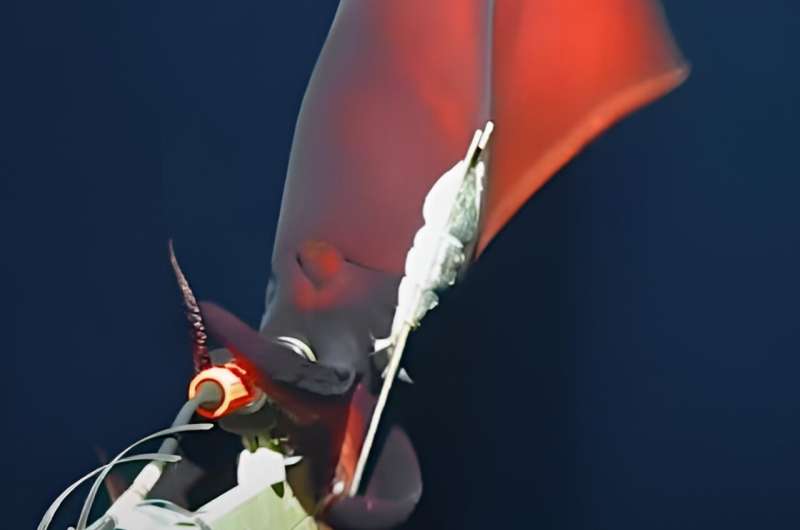Credit: University of Western Australia / Inkfish
A rare deep-sea squid has been captured on video at a depth of more than a kilometer underwater, by scientists from The University of Western Australia and Kelpie Geosciences in the UK.
A team from the Minderoo-UWA Deep Sea Research Centre and chief scientist Heather Stewart, from Kelpie Geosciences UK and an adjunct at UWA, captured the footage when they were deploying free-fall baited cameras north of an area known as the Samoan Passage.
After the camera was retrieved from a deployment of more than 5 km deep, researchers realized an animal rarely seen in its natural habitat had been captured on video.
At a depth of just over 1 km, a deep-sea hooked squid called Taningia danae caught up with the lander as it was sinking to seafloor at 58 meters per minute.
"As we were reviewing the footage, we realized we had captured something very rare," Associate Professor Stewart said.
The deep-sea hooked squid is one of the largest deep-water squid and is renowned for having two very large photophores on the end of two of its arms, which produce bright bioluminescent flashes to startle and disorientate prey when hunting. These are the largest known photophores in the natural world.
Credit: University of Western Australia
"The squid, which was about 75cm long, descended on our camera assuming it was prey, and tried to startle it with is huge bioluminescent headlights," Associate Professor Stewart said. "It then proceeded to wrap its arms around one of other cameras, which in turn captured the encounter in even greater detail. I think we were very lucky to have witnessed this."
Professor Alan Jamieson, director of the Minderoo-UWA Deep Sea Research Centre, said observing deep-sea squid in their natural habitat, especially in the mid-water, was notoriously challenging.
"Many records of this species are from strandings, accidental bycatch or from the stomach contents of whales," Professor Jamieson said. "The rarity of live observations of these amazing animals makes every encounter valuable in gathering information on geographic locations, depth, and behavior, plus it is such a unique animal that we hardly ever get to see, so we had to share it."
The research ship RV Dagon is currently in the final few weeks of a three-month expedition to the Nova Canton Trough located in the Central Pacific Ocean. The mission is to explore and document the biodiversity and geodiversity of the seafloor at depths between three and eight kilometers.
Provided by University of Western Australia























